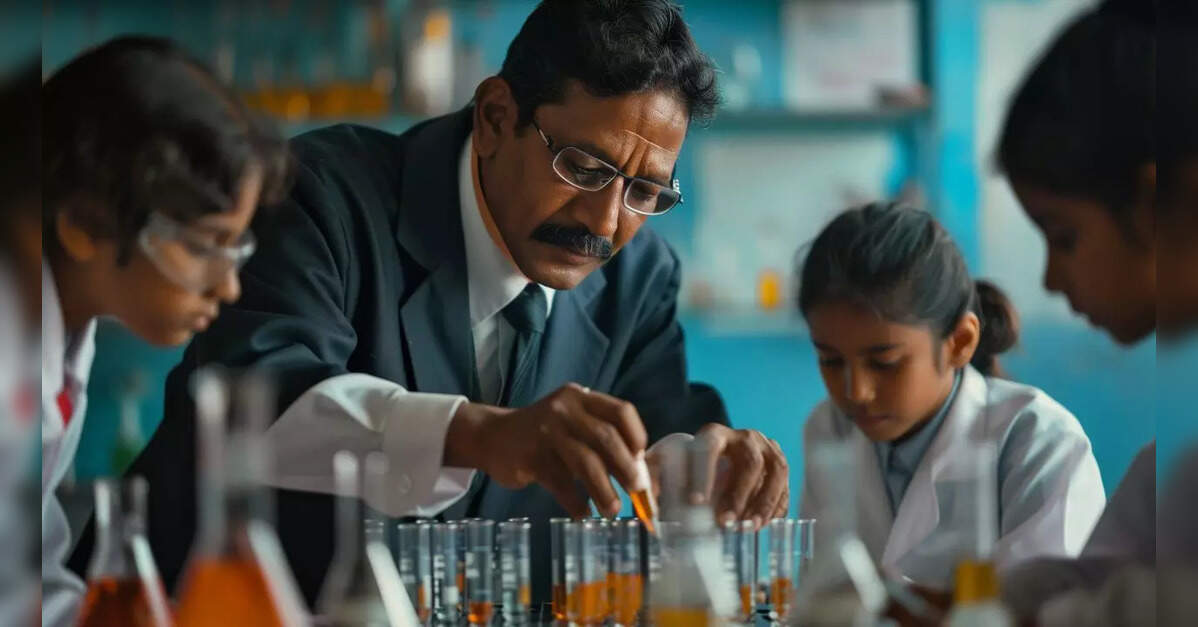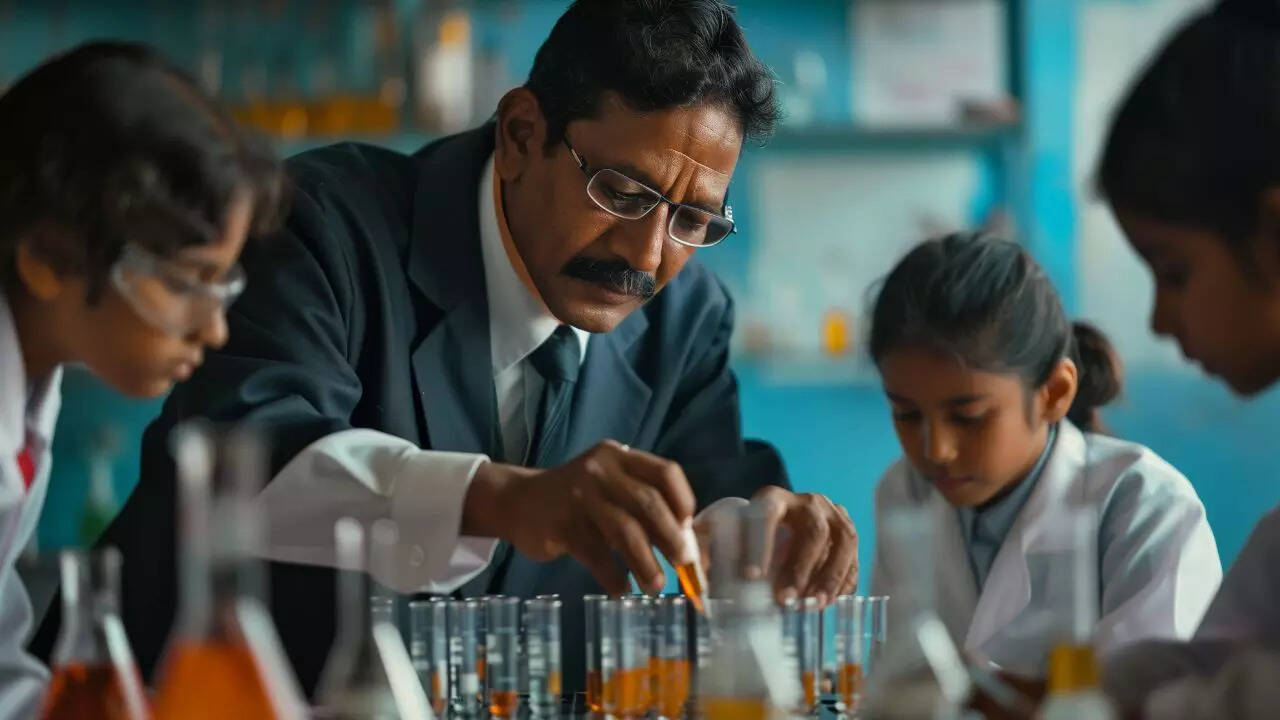
Collaboration Between Indian and Global Institutions, ETEducation

Brain drain is the reality of India. You know it. I’m aware. A pertinent question that looms over is, Why? On the flip side, there is minimal or no inflow of students from developed economies to India, despite renowned institutions like IITs, IIMs that have produced talented minds, today leading the largest industry players globally. Again, why?
In 2023-24, the education loan in India surged, and the public sector disbursed Rs. 28,699 crore in loans. This was a reflection of the rise in educational costs that the country saw in the fiscal year. Aspiring to study abroad, most Indian students end up stacking up education loans. In addition to a mere validation from a foreign university, what students look for is quality education that is research-driven and involves skill training to make students industry-ready. Can a foreign university offering a joint degree with an Indian institution, in India, be a cost-effective alternative?
In an exclusive interview with ETGovernment, Dr. Meenakshi Khurana, Executive Director, Dean Academics & Registrar, at Manav Rachna International Institute of Research and Studies (MRIIRS), and Dr. Athena Bangara, Director, South Asia, Monash University, opened up on their recent collaboration to offer dual degrees in computer science and IT domains.
(Edited excerpts)
Monash University and Manav Rachna International Institute of Research and Studies (MRIIRS) recently collaborated to offer dual degree programs in computer science and IT. Can you share some insights on how it all began, the idea, and how the journey of this partnership is going?
Dr. Meenakshi: It all started with the international offices of both universities getting in touch. After a set of initial meetings, academic directors and deans of the two institutions were roped in. There was some back and forth, and it took a few months for this partnership to take shape. We saw synergies, credits that both the universities have, and honoured it. The last bit was about documentation and official formalities.
Dr. Athena: As Dr. Meenakshi mentioned, these partnerships take a long while to establish. For us at Monash, it is about partnering with like-minded institutions. Institutions that are ambitious, a quality that is reflected in Manav Rachna’s ethos. We do not collaborate with each one out there, but it is about partnerships where values like ambition, complementarity lie. Moreover, the institutions should complement each other so that students benefit and academics can work together to support collective growth.
In a nutshell, the trust, the shared value, and a common vision are what form the core of this partnership between the two institutions.
The Indian diaspora, especially students in general, is strong academically in engineering, biological sciences, mathematics, and associated subjects. Why computer science and IT?
Dr. Athena: Initially, for partnerships like this, it is where the student demand is. For Monash University, it is not merely signing a piece of paper, but the actual movement of staff, students, ideas, and bringing the partnership to life. Hence, considering these factors, Computer Science and IT are just the beginning, a first step.
It is a good start, where the interest on both sides is addressed. However, in recent conversations, we have brainstormed about different areas of academics, research, and collaboration we can do together. Besides the inception with computer science and IT, the idea is really to grow that into other areas. As these programs take off, can we look at engineering? mathematics? Can we foster research collaborations in various areas? Hence, it is really about growing together over the years.
Dr. Meenakshi: Adding to Athena’s words, the Monash team, when it visited the MRIIRS campus, interacted with our senior management, we saw two areas that strongly emerged. We have a Center for Advanced Water Technology and Management. And we did talk to Athena and her team that water environment-linked research and project execution are significant for us. On the other side, Monash has a World Mosquito Program. The conversation immediately turned to studies on dengue. Hence, there are multiple areas under consideration. And, as Athena said, computer science and IT are just the beginning.
What are some of the key challenges that Indian institutions face in such collaborations? Do we have a proper policy structure from the government in place that facilitates such partnerships? Why is the number of such collaborations low?
Dr. Meenakshi: If we look at the past few years, the government has moved on from a regulatory to an enabling environment, in terms of collaborations with international institutions. This is the reason we are seeing many foreign universities coming to India now.
We were losing a significant number of our talented individuals to more developed economies, and brain drain was happening. The government is now providing an enabling environment where universities are coming forward for such partnerships and focusing on deriving value through exposure to global knowledge.
However, as a university, at times we are scared of frequent policy shifts or changes in guidelines, which cause uncertainty. As of now, we have policy frameworks that allow us to offer dual degrees or joint degrees, and a clear differentiation in the percentage of credits that either of the partners offers. And, I hope that these broader frameworks are encouraged.
Now, why less number of universities are going ahead with collaborations? I think there are certain financial barriers as well, besides administrative challenges. Hence, universities have to look into what kind of investments are required. Also, considering a majority of students in India do not have deep pockets, such mobility programs like dual degree arrangements or joint degree arrangements are costlier and hence at times difficult for universities and students to take up. Therefore, I think slow and steady is what the academic community is currently moving on with.
What challenges did Monash University face while getting into such partnerships? How did you manage to overcome these challenges?
Dr. Athena: As I mentioned earlier, the collaboration started with the international office. And, the first interaction is the key. When we get responsive environments on both sides, that’s where we see a match. That’s the first kind of hurdle to overcome. For us, it is about bringing academics into the partnership and getting them involved in the curriculum mapping, research opportunities, and more. This is essential as ultimately these academics will be teaching the students.
In some cases, we have faced challenges in the initial conversations where there may not be complete buy-in from the partner, or one side is keen, but the international office may not be as interested. At times, the decision makers or senior employees of the institution are not keen to join hands. At MRIIRS, we were well received, there was a significant buy-in very early, and the keenness to connect was driving both sides equally, leading to this partnership.
There has been immense support from the management, which further allowed the academics to engage meaningfully in the conversation. Therefore, having that high-level support is essential. In terms of other areas, India and Australia share a lot of challenges, maybe of different sizes and scales. Hence, with India-Australia collaboration, we bring complementary expertise and work together to solve the challenges. There is a significant opportunity for us, given the diversity we see in India.
What measures have you been taking in the dual degree program to ensure that the talent produced is industry-ready?
Dr. Athena: Monash University has a strong focus on industry-ready graduates. The government holds us to account in terms of graduate employability, ensuring that it is not just theoretical concepts, but that students become employable and contribute to society. Most of our curriculum is informed by industry. We have specific faculties, including the Faculty of IT at Monash, which has an industry advisory council working with the dean and senior leadership on trends that can be embedded in the curriculum.
There are opportunities for master classes, workshops, depending on the structure of the course and depending on the internships, work-integrated learning, and more. Industry is also well-connected with us in the research that we do.
Hence, at Monash as we are engaging with industry for research and blending it into the teaching to ensure that students are updated on current industrial trends and their curriculum is informed. Therefore, by the time students complete their studies, it is easier for them to become industry-ready. In addition, we support and help students prepare for interviews through mock interviews, develop their CVs, and take up internships during the course of study.
In India, most institutions offering graduate programs run theory-based courses with little or no practical exposure. How is MRIIRS closing that gap? Do you see a transition in academic institutions in this regard?
Dr. Meenakshi: If you look through my lens, a lot has changed over time. Industry now has a buyout in this process because they themselves have realised the expenses of retraining the graduates that they hire. Nowadays, the industry reaches out to the institutions to bring to light that theoretical learning is not what will take their students far. Hence, you see that initiatives like project-based learning, hackathons, internships, and industry interactions are a regular feature in university programs. Adding to what Athena highlighted, the courses today should not be restricted to industry inputs, but a comprehensive offering that prepares a graduate to contribute to the work environment right from day one.
At MRIIRS, we also have a career development center which, from the first day, starts preparing students on interpersonal skills, IQ, EQ, and how to perform in teams, how to take up floating leadership roles, and more. Further, there are corporate resource centers that are maintaining relationships with the industry to bring in that industry element.
I think none of the institutes can now shy away from providing their graduates an industry exposure. It has been there in the Manav Rachna and with the rising industry knowledge partners, it is becoming much stronger. The collaboration with foreign universities has added to the further development of that excellence. I’m sure that these students are not just preparing for jobs but for the opportunities of tomorrow.
In India, affordable quality education is a concern. Government institutions offer limited seats, most private universities charge a hefty premium, and studying abroad is synonymous to be buried in debt. Does collaboration with foreign universities serve as a gateway to quality, research-driven education on a budget? Secondly, from your perspective as an industry veteran, should elite institutions like IITs, IIMs also enhance collaborations with foreign universities?
Dr. Meenakshi: I think none of the reputed institutions or elite institutions in the world can now think of operating in silos. Hence, it is essential for private or government universities, or IITs/IIMs, to go out on a global scale. We need to ponder why the global talent is not coming to Indian institutions, whereas we are producing the CEOs and CTOs of the world’s top companies. Why is it that nobody from the developed countries is ready to come to India, where we have elite institutions like IITs and IIMs.
We are not featured among the top institutions in the QS rankings. Again, what is stopping us? It is that we are operating in silo. Therefore, it is crucial for any institution to head for global tie-ups. Recently, we have seen this shift happening and relationships being developed.
As far as affordability is concerned, we know that a large number of students travel abroad for their undergraduate or master’s degrees, and their parents take up loans to facilitate their education. With foreign institutions coming to India and institutions like MRIIRS partnering with them to offer dual degrees, it can bring down costs to almost half or even less. Students, after passing class 12th or high school, go abroad for higher education. They face two major challenges: the first is the new academic environment, and the second is a cultural and emotional shift. Indian institutions collaborating with foreign universities address both the issues and reduce cost by almost half. Hence, apart from addressing the cost concern, we are enabling these students and preparing them for their journey abroad through a value-led exposure in their home country.
Looking ahead, I think with more foreign universities coming to India, more collaborations, the cost will further reduce because then we will have ample resources, which, at present, are restricted.
While we see more such collaborations further, is there a possibility that the entire education fraternity in India joins hands with the government to create certain scholarships or facilitation programs to help students attend such dual degree courses and earn global exposure conveniently?
Dr. Meenakshi: We always can. In India, there is a huge talent pool and the government is already promoting education for the students, especially those from the weaker sections of society. In the government institutions, students are enabled to join courses, and even to attend coaching to develop proficiency in subjects. Further, there is a quota of seats for students in the government institutions, and they are providing all kinds of help to these students. Now, how much of that can be extended to global institutions or private institutions, is something which the government can always consider.
To get a glimpse of the Government of Australia’s perspective, how is the government supporting educational and research institutions, especially when it comes to collaborations with global universities?
Dr. Athena: The Government of Australia has always been supportive of the internationalisation of Australian universities. There is hardly any Australian university that does not have global collaboration. However, the mechanism that drives institutions is supported by the government and the authorities provide an enabling environment to promote the developments in the education sector. Even at the signing of the MoU, we had a representative from Australia’s Department of Education and colleagues from the High Commission who were in support of this. Moreover, there is a whole spectrum of activities: it could be dual degrees, articulations, foreign branch campuses, and more, but overall the government is about providing a supportive enabling environment in order for us to collaborate. However, the decision on where to collaborate, how to collaborate, and with whom to collaborate are all institutional decisions.
Considering India’s elite institutions like IITs and IIMs, they are quite different in their approach, but have also started engaging significantly with international universities. Monash has a joint PhD academy with IIT Bombay. We, recently, celebrated a convocation on where we had 265 to 270 graduates from the program. We also had a significant collaboration with IIT Hyderabad on research on critical minerals. The collaborations with the IITs tend to be more research-driven.
In denouement
Dr. Meenakshi: Not specific to Monash University or MRIIRS, but my learning from these global tie-ups is that the Indian institutions need to come to the table as equal partners. Indian institutions should not be looked upon as just the feeders for the foreign partner so it has to be an equal partnership. I believe that the measure of success for all these partnerships will be twofold: first would be the experience of our students once they are with the foreign partner and second will be a long-lasting relationships we build.
Dr. Athena: Indeed, such collaborations are about fostering a mutual relationship led by a progressive approach from both sides. This also ensures that the flow of students is not unidirectional. Moreover, it enables staff visits for sharing expertise and driving collaborative research. Moving ahead, I think we have to learn from each other and strengthen the relationship benefiting both the institutions.
Source link



